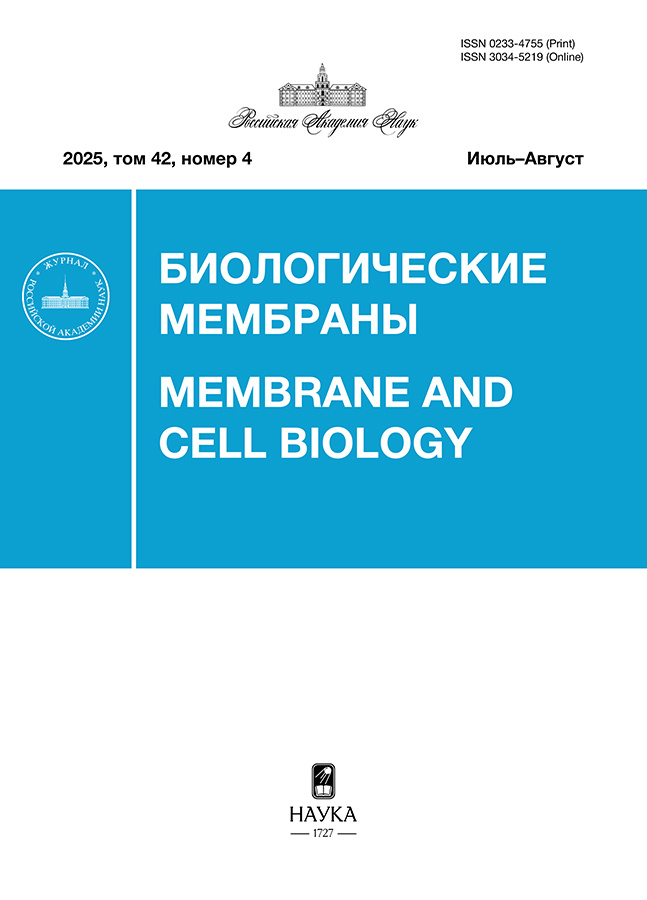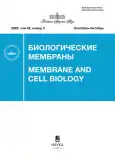Посттрансляционные модификации белков с неупорядоченной структурой в регуляции регенерации и нейродегенерации клеток мозга
- Авторы: Демьяненко С.В.1, Хайтин А.М.1, Батальщикова С.А.1
-
Учреждения:
- Южный федеральный университет, Академия биологии и биотехнологии им. Д.И. Ивановского
- Выпуск: Том 42, № 5 (2025)
- Страницы: 347-355
- Раздел: ОБЗОРЫ
- URL: https://journal-vniispk.ru/0233-4755/article/view/353189
- DOI: https://doi.org/10.31857/S0233475525050013
- ID: 353189
Цитировать
Аннотация
Обзор посвящен роли внутренне-неупорядоченных белков и их посттрансляционных модификаций в регуляции процессов нейрорегенерации и нейродегенерации. Внутренне-неупорядоченные белки, обладая высокой конформационной гибкостью и отсутствием стабильной третичной структуры, способны участвовать в множестве клеточных процессов за счет динамичных и специфичных взаимодействий с различными партнерами. Они вовлечены в регуляцию транскрипции, апоптоза, клеточного цикла и стрессовых ответов. Ключевыми примерами таких белков являются факторы транскрипции p53, c-Myc, FOXO3a и E2F1, которые в зависимости от набора посттрансляционных модификаций могут переключаться между функциями защиты нейронов и активации их гибели. Особое внимание уделяется механизмам, посредством которых посттрансляционные модификации, такие как ацетилирование, фосфорилирование, убиквитинирование, изменяют локализацию, стабильность и активность внутренне-неупорядоченных белков, влияя на исход клеточной судьбы. Также рассматривается вклад неправильно свернутых белков со структурно-неупорядоченными доменами, таких как Tau и α-синуклеин, в патогенез нейродегенеративных состояний. В статье подчеркиваются сложности, связанные с терапевтическим таргетированием этих белков, обусловленные их структурной пластичностью и многообразием посттрансляционных модификаций. Обсуждаются перспективные подходы к воздействию на общую активность и функциональное состояние белков-мишеней, включая модуляцию активности ферментов, посттрансляционной модификации и механизмов протеостаза. Обзор иллюстрирует критическую необходимость комплексного изучения посттрансляционных модификаций как механизмов регуляции неупорядоченных белков для разработки новых стратегий терапии острых повреждений нервных клеток и нейродегенеративных заболеваний.
Об авторах
С. В. Демьяненко
Южный федеральный университет, Академия биологии и биотехнологии им. Д.И. Ивановского
Email: svdemyanenko@sfedu.ru
Ростов-на-Дону, 344090 Россия
А. М. Хайтин
Южный федеральный университет, Академия биологии и биотехнологии им. Д.И. Ивановского
Email: svdemyanenko@sfedu.ru
Ростов-на-Дону, 344090 Россия
С. А. Батальщикова
Южный федеральный университет, Академия биологии и биотехнологии им. Д.И. Ивановского
Автор, ответственный за переписку.
Email: svdemyanenko@sfedu.ru
Ростов-на-Дону, 344090 Россия
Список литературы
- Wright P.E., Dyson H.J. 2015. Intrinsically disordered proteins in cellular signalling and regulation. Nat. Rev. Mol. Cell Biol. 16, 18–29. https://doi.org/10.1038/nrm3920
- Trivedi R., Nagarajaram H.A. 2022. Intrinsically disordered proteins: An overview. Int. J. Mol. Sci. 23, 14050. https://doi.org/10.3390/ijms232214050
- Khaitin A.M., Guzenko V.V., Bachurin S.S., Demyanenko S.V. 2024. c-Myc and FOXO3a – The everlasting decision between neural regeneration and degeneration. Int. J. Mol. Sci. 25, 12621. https://doi.org/10.3390/ijms252312621
- Khoury G.A., Baliban R.C., Floudas C.A. 2011. Proteome-wide post-translational modification statistics: Frequency analysis and curation of the swiss-prot database. Sci. Rep. 1, 90. https://doi.org/10.1038/srep00090
- Iakoucheva L.M. 2004. The importance of intrinsic disorder for protein phosphorylation. Nucleic Acids Res. 32, 1037–1049. https://doi.org/10.1093/nar/gkh253
- Narasumani M., Harrison P.M. 2018. Discerning evolutionary trends in post-translational modification and the effect of intrinsic disorder: Analysis of methylation, acetylation and ubiquitination sites in human proteins. PLOS Comput. Biol. 14, e1006349. https://doi.org/10.1371/journal.pcbi.1006349
- Cesaro L., Pinna L.A., Salvi M. 2015. A comparative analysis and review of lysyl residues affected by posttranslational modifications. Curr. Genomics. 16, 128–138. https://doi.org/10.2174/1389202916666150216221038
- Lee T.-Y. 2006. dbPTM: An information repository of protein post-translational modification. Nucleic Acids Res. 34, D622–627. https://doi.org/10.1093/nar/gkj083
- Johnson L.N., Lewis R.J. 2001. Structural basis for control by phosphorylation. Chem. Rev. 101, 2209–2242. https://doi.org/10.1021/cr000225s
- Guzenko V.V., Bachurin S.S., Khaitin A.M., Dzreyan V.A., Kalyuzhnaya Y.N., Bin H., Demyanenko S.V. 2023. Acetylation of p53 in the cerebral cortex after photothrombotic stroke. Transl. Stroke Res. 15, 970–985. https://doi.org/10.1007/s12975-023-01183-z
- Guzenko V.V., Bachurin S.S., Dzreyan V.A., Khaitin A.M., Kalyuzhnaya Y.N., Demyanenko S.V. 2024. Acetylation of c-Myc at Lysine 148 protects neurons after ischemia. Neuromolecular Med. 26, 8. https://doi.org/10.1007/s12017-024-08777-2
- Castillo D.S., Campalans A., Belluscio L.M., Carcagno A.L., Radicella J.P., Cánepa E.T., Pregi N. 2015. E2F1 and E2F2 induction in response to DNA damage preserves genomic stability in neuronal cells. Cell Cycle. 14, 1300–1314. https://doi.org/10.4161/15384101.2014.985031
- Zhang Y., Song X., Herrup K. 2020. Context-dependent functions of E2F1: Cell cycle, cell death, and DNA damage repair in cortical neurons. Mol. Neurobiol. 57, 2377–2390. https://doi.org/10.1007/s12035-020-01887-5
- Uzdensky A.B. 2019. Apoptosis regulation in the penumbra after ischemic stroke: Expression of pro- and antiapoptotic proteins. Apoptosis. 24, 687–702. https://doi.org/10.1007/s10495-019-01556-6
- Zhu W.-G. 2017. Regulation of p53 acetylation. Sci. China Life Sci. 60, 321–323. https://doi.org/10.1007/s11427-016-0353-0
- Demyanenko S., Dzreyan V., Sharifulina S. 2021. Histone deacetylases and their isoform-specific inhibitors in ischemic stroke. Biomedicines. 9, 1445. https://doi.org/10.3390/biomedicines9101445
- Raz L., Zhang Q., Han D., Dong Y., De Sevilla L., Brann D.W. 2011. Acetylation of the pro-apoptotic factor, p53 in the hippocampus following cerebral ischemia and modulation by estrogen. PLoS ONE. 6, e27039. https://doi.org/10.1371/journal.pone.0027039
- Wi S., Yu J.H., Kim M., Cho S.-R. 2016. In Vivo expression of reprogramming factors increases hippocampal neurogenesis and synaptic plasticity in chronic hypoxic-ischemic brain injury. Neural. Plast. 2016, 2580837. https://doi.org/10.1155/2016/2580837
- Demyanenko S., Uzdensky A. 2017. Profiling of signaling proteins in penumbra after focal photothrombotic infarct in the rat brain cortex. Mol. Neurobiol. 54, 6839–6856. https://doi.org/10.1007/s12035-016-0191-x
- Venkateswaran N., Conacci-Sorrell M. 2020. MYC leads the way. Small GTPases. 11, 86–94. https://doi.org/10.1080/21541248.2017.1364821
- Das S.K., Lewis B.A., Levens D. 2023. MYC: a complex problem. Trends Cell Biol. 33, 235–246. https://doi.org/10.1016/j.tcb.2022.07.006
- Farrell A.S., Sears R.C. 2014. MYC degradation. Cold Spring Harb. Perspect. Med. 4, a014365–a014365. https://doi.org/10.1101/cshperspect.a014365
- Marinkovic T., Marinkovic D. 2021. Obscure involvement of MYC in neurodegenerative diseases and neuronal repair. Mol. Neurobiol. 58, 4169–4177. https://doi.org/10.1007/s12035-021-02406-w
- Hu W., Yang Z., Yang W., Han M., Xu B., Yu Z., Shen M., Yang Y. 2019. Roles of forkhead box O (FoxO) transcription factors in neurodegenerative diseases: A panoramic view. Prog. Neurobiol. 181, 101645. https://doi.org/10.1016/j.pneurobio.2019.101645
- Calissi G., Lam E.W.-F., Link W. 2021. Therapeutic strategies targeting FOXO transcription factors. Nat. Rev. Drug Discov. 20, 21–38. https://doi.org/10.1038/s41573-020-0088-2
- Wang X., Hu S., Liu L. 2017. Phosphorylation and acetylation modifications of FOXO3a: Independently or synergistically? Oncol. Lett. 13, 2867–2872. https://doi.org/10.3892/ol.2017.5851
- Wang Z., Yu T., Huang P. 2016. Post-translational modifications of FOXO family proteins (Review). Mol. Med. Rep. 14, 4931–4941. https://doi.org/10.3892/mmr.2016.5867
- Ferber E.C., Peck B., Delpuech O., Bell G.P., East P., Schulze A. 2012. FOXO3a regulates reactive oxygen metabolism by inhibiting mitochondrial gene expression. Cell Death Differ. 19, 968–979. https://doi.org/10.1038/cdd.2011.179
- Daitoku H., Sakamaki J., Fukamizu A. 2011. Regulation of FoxO transcription factors by acetylation and protein–protein interactions. Biochim. Biophys. Acta. 1813, 1954–1960. https://doi.org/10.1016/j.bbamcr.2011.03.001
- Martínez-Balbás M.A., Bauer U.M., Nielsen S.J., Brehm A., Kouzarides T. 2000. Regulation of E2F1 activity by acetylation. EMBO J. 19, 662–671. https://doi.org/10.1093/emboj/19.4.662
- Hou S.T., Callaghan D., Fournier M., Hill I., Kang L., Massie B., Morley P., Murray C., Rasquinha I., Slack R., MacManus J.P. 2000. The transcription factor E2F1 modulates apoptosis of neurons. J. Neurochem. 75, 91–100. https://doi.org/10.1046/j.1471-4159.2000.0750091.x
- Pediconi N., Ianari A., Costanzo A., Belloni L., Gallo R., Cimino L., Porcellini A., Screpanti I., Balsano C., Alesse E., Gulino A., Levrero M. 2003. Differential regulation of E2F1 apoptotic target genes in response to DNA damage. Nat. Cell Biol. 5, 552–558. https://doi.org/10.1038/ncb998
- Stevens C., Smith L., La Thangue N.B. 2003. Chk2 activates E2F-1 in response to DNA damage. Nat. Cell Biol. 5, 401–409. https://doi.org/10.1038/ncb974
- Manickavinayaham S., Velez-Cruz R., Biswas A.K., Chen J., Guo R., Johnson D.G. 2020. The E2F1 transcription factor and RB tumor suppressor moonlight as DNA repair factors. Cell Cycle. 19, 2260–2269. https://doi.org/10.1080/15384101.2020.1801190
- Hofmann F., Martelli F., Livingston D.M., Wang Z. 1996. The retinoblastoma gene product protects E2F-1 from degradation by the ubiquitin-proteasome pathway. Genes Dev. 10, 2949–2959. https://doi.org/10.1101/gad.10.23.2949
- Dick F.A., Dyson N. 2003. pRB contains an E2F1-specific binding domain that allows E2F1-induced apoptosis to be regulated separately from other E2F activities. Mol. Cell. 12, 639–649. https://doi.org/10.1016/S1097-2765(03)00344-7
- Utami K.H., Morimoto S., Mitsukura Y., Okano H. 2025. The roles of intrinsically disordered proteins in neurodegeneration. Biochim. Biophys. Acta. 1869, 130772. https://doi.org/10.1016/j.bbagen.2025.130772
- Meade R.M., Fairlie D.P., Mason J.M. 2019. Alpha-synuclein structure and Parkinson’s disease – lessons and emerging principles. Mol. Neurodegener. 14, 29. https://doi.org/10.1186/s13024-019-0329-1
- Uversky V.N. 2025. How to drug a cloud? Targeting intrinsically disordered proteins. Pharmacol. Rev. 77, 100016. https://doi.org/10.1124/pharmrev.124.001113
- Neira J.L., Bintz J., Arruebo M., Rizzuti B., Bonacci T., Vega S., Lanas A., Velázquez-Campoy A., Iovanna J.L., Abián O. 2017. Identification of a drug targeting an intrinsically disordered protein involved in pancreatic adenocarcinoma. Sci. Rep. 7, 39732. https://doi.org/10.1038/srep39732
- Santofimia-Castaño P., Rizzuti B., Xia Y., Abian O., Peng L., Velázquez-Campoy A., Neira J.L., Iovanna J. 2020. Targeting intrinsically disordered proteins involved in cancer. Cell. Mol. Life Sci. 77, 1695–1707. https://doi.org/10.1007/s00018-019-03347-3
- Pegoraro S., Ros G., Sgubin M., Petrosino S., Zambelli A., Sgarra R., Manfioletti G. 2020. Targeting the intrinsically disordered architectural High Mobility Group A (HMGA) oncoproteins in breast cancer: learning from the past to design future strategies. Expert Opin. Ther. Targets. 24, 953–969. https://doi.org/10.1080/14728222.2020.1814738
- Guzenko V.V., Bachurin S.S., Khaitin A.M., Borisenko E.A., Demyanenko S.V. 2025. Effects of E2F1 Point acetylation at Lysine 117 or 125 on neuronal apoptosis after ischemic injury. Neurochem. Res. 50, 202. https://doi.org/10.1007/s11064-025-04453-4
- Uversky V.N. 2010. Targeting intrinsically disordered proteins in neurodegenerative and protein dysfunction diseases: Another illustration of the D2 concept. Expert Rev. Proteomics. 7, 543–564. https://doi.org/10.1586/epr.10.36
- Coskuner O., Uversky V.N. 2019. Intrinsically disordered proteins in various hypotheses on the pathogenesis of Alzheimer’s and Parkinson’s diseases. In: Progress in Molecular Biology and Translational Science, vol. 166. Elsevier, p. 145–223. https://doi.org/10.1016/bs.pmbts.2019.05.007
- Norris V., Oláh J., Krylov S.N., Uversky V.N., Ovádi J. 2023. The Sherpa hypothesis: Phenotype-Preserving Disordered Proteins stabilize the phenotypes of neurons and oligodendrocytes. Npj Syst. Biol. Appl. 9, 31. https://doi.org/10.1038/s41540-023-00291-8
- Lee J.M., Hammarén H.M., Savitski M.M., Baek S.H. 2023. Control of protein stability by post-translational modifications. Nat. Commun. 14, 201. https://doi.org/10.1038/s41467-023-35795-8
- Rutledge B.S., Choy W.-Y., Duennwald M.L. 2022. Folding or holding?–Hsp70 and Hsp90 chaperoning of misfolded proteins in neurodegenerative disease. J. Biol. Chem. 298, 101905. https://doi.org/10.1016/j.jbc.2022.101905
- Cai Z., Yang Z., Li H., Fang Y. 2024. Research progress of PROTACs for neurodegenerative diseases therapy. Bioorganic Chem. 147, 107386. https://doi.org/10.1016/j.bioorg.2024.107386
Дополнительные файлы










